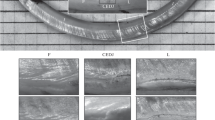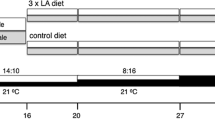Abstract
Dentin is deposited on a circadian basis, and daily layers manifest as bands on the medial surfaces of rodent incisors. Hibernation alters dentin deposition, and a distinct hibernation mark has been described on incisor surfaces of several rodent species; the factors that influence the morphology of this mark are poorly understood. We tested the effects of day length, torpor expression, and ambient temperature on incisor surface morphology in Turkish hamsters housed in one of four conditions: long days (LDs) at 22 °C, short days (SDs) at 22 °C, SDs at 5 °C, and SDs at 13 °C. Body temperature was monitored continuously with implanted radio transmitters, and teeth examined postmortem. Teeth of SD hamsters had narrower, less distinct circadian increments than those of LD hamsters, but the width of ultradian increments was similar in both photoperiods. Hibernation at both 5 and 13 °C was associated in most specimens with very narrow, sharply defined dentin increments and increased tooth heterogeneity. Hamsters in SDs at 5 °C that did not hibernate lacked characteristic hibernation increments. At 5 °C, but not 13 °C, the number and cumulative width of hibernation increments were related to number and cumulative duration of periodic arousals. Our results suggest that incremental deposition of dentin in rodent incisors may be a useful trait for characterizing hibernation behavior in both evolutionary and historical contexts.




Similar content being viewed by others
Abbreviations
- LD:
-
Long day
- SD:
-
Short day
- T b :
-
Body temperature
- T a :
-
Ambient temperature
References
Augee ML, Gooden BA (1992) Monotreme hibernation—some afterthoughts. In: Augee ML (ed) Platypus and Echidnas. Royal Zoological Society of New South Wales, Sydney, pp 174–176
Barclay RMR, Lausen CL, Hollis L (2001) What’s hot and what’s not: defining torpor in free-ranging birds and mammals. Can J Zool 79:1885–1890
Bartness TJ, Milner R, Geloen A, Trayhurn P (1991) Effects of high fat diets on hibernation and adipose tissue in Turkish hamsters. J Comp Physiol B 161:451–459
Bartness TJ, Powers JB, Hastings MH, Bittman EL, Goldman BD (1993) The timed infusion paradigm for melatonin delivery: what has it taught us about the melatonin signal, its reception, and the photoperiodic control of seasonal responses? J Pineal Res 15:161–190
Batavia M, Nguyen G, Harman K, Zucker I (2012) Hibernation patterns of Turkish hamsters: influence of sex and ambient temperature. J Comp Physiol B. doi:10.1007/s00360-012-0706-3
Boyles JG, Seebacher F, Smit B, McKechnie AE (2011) Adaptive thermoregulation in endotherms may alter responses to climate change. Integr Comp Biol 51:676–690
Butler MP, Turner KW, Zucker I (2008) A melatonin-independent seasonal timer induces neuroendocrine refractoriness to short day lengths. J Biol Rhythms 23:242–251
Carey HV, Andrews MT, Martin SL (2003) Mammalian hibernation: cellular and molecular responses to depressed metabolism and low temperature. Physiol Rev 83:1153–1181
Dark J, Zucker I, Wade GN (1983) Photoperiodic regulation of body mass, food intake, and reproduction in meadow voles. Am J Physiol 245:R334–R338
Darrow JM, Tamarkin L, Duncan MJ, Goldman BD (1986) Pineal melatonin rhythms in female Turkish hamsters: effects of photoperiod and hibernation. Biol Reprod 35:74–83
Duncan MJ, Goldman BD (1984) Hormonal regulation of the annual pelage color cycle in the Djungarian hamster, Phodopus sungorus. I. Role of the gonads and pituitary. J Exp Zool 230:89–95
Erickson GM (1996) Daily deposition of dentine in juvenile alligator and assessment of tooth replacement rates using incremental line counts. J Morphol 228:189–194
Geiser F (1998) Evolution of daily torpor and hibernation in birds and mammals: importance of body size. Clin Exp Pharmacol Physiol 25:736–740
Geiser F (2004) Metabolic rate and body temperature reduction during hibernation and daily torpor. Annu Rev Physiol 66:239–274
Geiser F, Ruf T (1995) Hibernation versus daily torpor in mammals and birds: physiological variables and classification of torpor patterns. Physiol Zool 68:935–966
Goldman BD (2001) Mammalian photoperiodic system: formal properties and neuroendocrine mechanisms of photoperiodic time measurement. J Biol Rhythms 16:283–301
Goldman BD, Darrow JM (1987) Effects of photoperiod on hibernation in castrated Turkish hamsters. Am J Physiol 253:R337–R343
Goodwin HT, Ryckman EM (2006) Lower incisors of prairie dogs (Cynomys) as biorecorders of hibernation and season of death. J Mamm 87:1002–1012
Goodwin HT, Michener GR, Gonzalez D, Rinaldi CR (2005) Hibernation is recorded in lower incisors of recent and fossil ground squirrels (Spermophilus). J Mamm 86:323–332
Grigg G, Beard L (2000) Hibernation by echidnas in mild climates: hints about the evolution of endothermy? In: Heldmaier G, Klingenspor M (eds) Life in the cold: eleventh international hibernation symposium. Springer, Berlin, pp 5–19
Grigg GC, Beard LA, Augee ML (2004) The evolution of endothermy and its diversity in mammals and birds. Physiol Biochem Zool 77:982–997
Hall V, Goldman B (1980) Effects of gonadal steroid hormones on hibernation in the Turkish hamster (Mesocricetus brandti). J Comp Physiol 135:107–114
Hall V, Goldman B (1982) Hibernation in the female Turkish hamster (Mesocricetus brandti): an investigation of the role of the ovaries and of photoperiod. Biol Reprod 27:811–815
Hall VD, Bartke A, Goldman BD (1982) Role of the testis in regulating the duration of hibernation in the Turkish hamster, Mesocricetus brandti. Biol Reprod 27:802–810
Heldmaier G, Steinlechner S, Ruf T, Wiesinger H, Klingenspor M (1989) Photoperiod and thermoregulation in vertebrates: body temperature rhythms and thermogenic acclimation. J Biol Rhythm 4:251–265
Heldmaier G, Ortmann S, Elvert R (2004) Natural hypometabolism during hibernation and daily torpor in mammals. Respir Physiol Neurobiol 141:317–329
Helgen KM, Cole FR, Helgen LE, Wilson DE (2009) Generic revision in the Holarctic ground squirrel genus Spermophilus. J Mamm 90:270–305
Hong SM, Stetson MH (1988) Termination of gonadal refractoriness in Turkish hamsters, Mesocricetus brandti. Biol Reprod 38:639–643
Hong SM, Rollag MD, Stetson MH (1986) Maintenance of testicular function in Turkish hamsters: interaction of photoperiod and the pineal gland. Biol Reprod 34:527–531
Huber M, Nof D (2006) The ocean circulation in the southern hemisphere and its climatic impacts in the Eocene. Palaeogeogr Palaeoclimatol Palaeoecol 231:9–28
Humphries MM, Thomas DW, Speakman JR (2002) Climate-mediated energetic constraints on the distribution of hibernating mammals. Nature 418:313–316
Humphries MM, Umbanhowar J, McCann KS (2004) Bioenergetic prediction of climate change impacts on northern mammals. Integr Comp Biol 44:152–162
Inouye DW, Barr B, Armitage KB, Inouye BD (2000) Climate change is affecting altitudinal migrants and hibernating species. Proc Natl Acad Sci 97:1630–1633
Jarjisian SG, Zucker I (2011) Elimination of short-day melatonin signaling accelerates gonadal recrudescence but does not break refractoriness in male Turkish hamsters. J Biol Rhythms 26:130–135
Klevezal GA (1996) Recording structures of mammals: determination of age and reconstruction of life history. A.A Balkema, Rotterdam
Klevezal GA (2010) Dynamics of incisor growth and daily increments on the incisor surface in three species of small rodents. Biol Bull 37:836–845
Klevezal GA, Lobkov VA (2008) Daily Increments and the “dormancy zone” on the surface of incisors in ground squirrels of the genus Spermophilus. Zool Zh 87:1495–1503
Klevezal GA, Mina MV (1990) Daily layers and hibernation marks in incisor dentin of Sicista pseudonapaea and some biological remarks. Acta Theriol 35:345–356
Körtner G, Geiser F (2000) The temporal organization of daily torpor and hibernation: circadian and circannual rhythms. Chronobiol Int 17:103–128
Lovegrove BG (2012) The evolution of endothermy in Cenozoic mammals: a plesiomorphic–apomorphic continuum. Biol Rev 87:128–162
Lyman CP, O’Brien RC, Greene GC, Papafrangos ED (1981) Hibernation and longevity in the Turkish hamster Mesocricetus brandti. Science 212:668–670
Lyman CP, Willis JS, Malan A, Wang LCH (1982) Hibernation and torpor in mammals and birds. Academic Press, New York
Lyman CP, O’Brien RC, Bossert WH (1983) Differences in tendency to hibernate among groups of Turkish hamsters (Mesocricetus brandti). J Therm Biol 8:255–257
Malan A (1996) The origins of hibernation: a reappraisal. In: Geiser F, Hulbert AJ, Nicol SC (eds) Adaptations to the cold: tenth international hibernation symposium. University of New England Press, Armidale, pp 1–6
Markwick PJ (1998) Fossil crocodilians as indicators of late Cretaceous and Cenozoic climates: implications for using palaeontological data in reconstructing palaeoclimate. Palaeogeogr Palaeoclimatol Palaeoecol 137:205–271
Ohtsuka M, Shinoda H (1995) Ontogeny of circadian dentinogenesis in the rat incisor. Arch Oral Biol 40:481–485
Ohtsuka M, Saeki S, Igarashi K, Shinoda H (1998) Circadian rhythms in the incorporation and secretion of 3H-proline by odontoblasts in relation to incremental lines in rat dentin. J Dent Res 77:1889–1895
Prendergast BJ, Zucker I (2012) Photoperiodic influences on ultradian rhythms of male Siberian hamsters. PLoS ONE 7:e41723. doi:10.1371/journal.pone.0041723
Prendergast BJ, Kriegsfeld LJ, Nelson RJ (2001) Photoperiodic polyphenisms in rodents: neuroendocrine mechanisms, costs, and functions. Q Rev Biol 76:293–325
Puchalski W, Bulova SJ, Lynch CB, Lynch GR (1988) Photoperiod, temperature and melatonin effects on thermoregulatory behavior in Djungarian hamsters. Physiol Behav 42:173–177
Reeder DM, Frank CL, Turner GG, Meteyer CU, Kurta A, Britzke ER, Vodzak ME, Darling SR, Stihler CW, Hicks AC, Jacob R, Grieneisen LE, Brownlee SA, Muller LK, Blehert DS (2012) Frequent arousal from hibernation linked to severity of infection and mortality in bats with white-nose syndrome. PLoS ONE 7:e38920. doi:10.1371/journal.pone.0038920
Rinaldi C (1995) A new technique for assessing the incremental growth of rodent incisors. In: Radlanski RJ and Renz H (eds) Proceedings of the 10th international symposium on dental morphology ‘‘M’’ Marketing Services, Berlin, pp 190–194
Rinaldi C (1999) A record of hibernation in the incisor teeth of recent and fossil marmots (Marmota flaviventris) In: Mayhall J (ed) Dental morphology 1998 proceedings of the 11th international symposium of dental morphology. Oulu University Press, Oulu, pp 112–119
Rinaldi C, Cole TM (2004) Environmental seasonality and incremental growth rates of beaver (Castor canadensis) incisors: implications for palaeobiology. Palaeogeogr Palaeoclimatol Palaeoecol 206:289–301
Rosenberg GD, Simmons DJ (1980) Rhythmic dentinogenesis in the rabbit incisor: circadian, ultradian, infradian periods. Calcif Tissue Int 32:29–44
Schour I, Steadman S (1935) The growth pattern and daily rhythm of the incisor of the rat. Anat Rec 63:325–333
Selkova YE (2003) Incisor dentin of hibernating rodents as an indicator of some climatic factors. Dokl Biol Sci 393:535–538
Stetson MH, Hamilton B (1981) The anovulatory hamster: a comparison of the effects of short photoperiod and daily melatonin injections on the induction and termination of ovarian acyclicity. J Exp Zool 215:173–178
Trunova YE, Klevezal GA (1999) Interspecific variation of hibernation marks in incisor dentin of rodents. Zool Zh 78:1455–1464
Trunova YE, Lobkov VA (1997) Recording hibernation features by incisor dentin of Spermophilus suslicus (Sciuridae, Rodentia). Zool Zh 76:940–947
Vander Wall SB (1990) Food hoarding in mammals. University of Chicago Press, Chicago
Wang LCH (1978) Energetic and field aspect of mammalian torpor: the Richardson’s ground squirrel. In: Wang LCH, Hudson JW (eds) Strategies in the cold. Academic Press, New York, pp 109–145
Acknowledgments
We thank Monica Albe, Steve Jarjisian, Lance Kriegsfeld, Kim Pelz, Denise Schichnes, and Chris Tuthill for technical assistance, Kristine Harman, Karen Molina and Michael Li for help with animal care, Aaron Cheng for help preparing figures, and Eileen Lacey and two anonymous reviewers for helpful comments on the manuscript.
Author information
Authors and Affiliations
Corresponding author
Additional information
Communicated by G. Heldmaier.
Rights and permissions
About this article
Cite this article
Batavia, M., Nguyen, G. & Zucker, I. The effects of day length, hibernation, and ambient temperature on incisor dentin in the Turkish hamster (Mesocricetus brandti). J Comp Physiol B 183, 557–566 (2013). https://doi.org/10.1007/s00360-012-0729-9
Received:
Revised:
Accepted:
Published:
Issue Date:
DOI: https://doi.org/10.1007/s00360-012-0729-9




